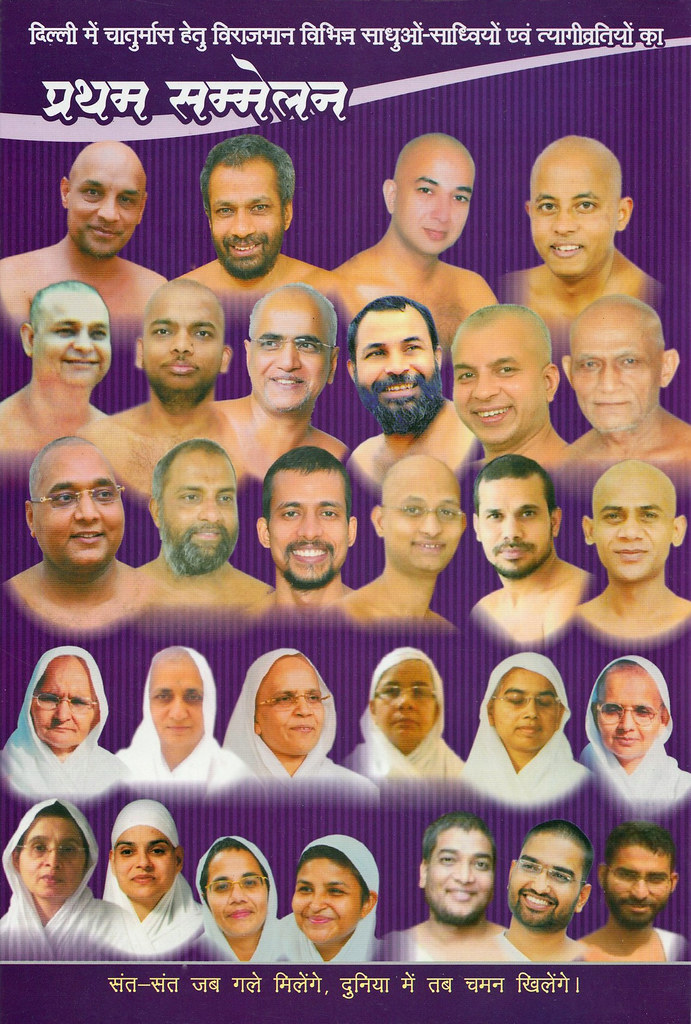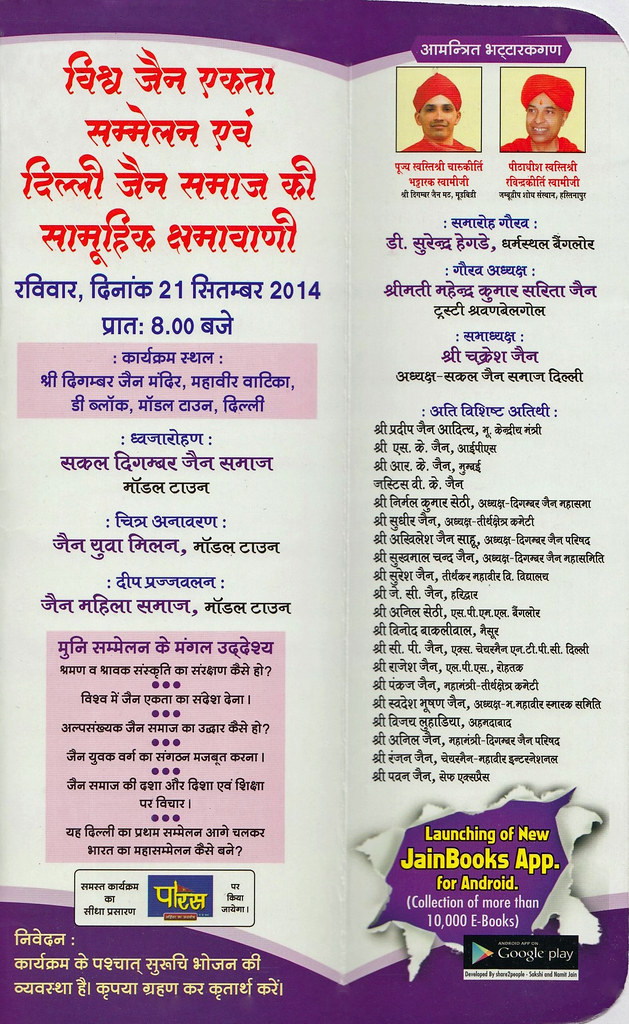
First ever meeting of Jain Munis, Sadhus and Sadhvis in Model Town (Delhi) on September 21, 2014 as part of World Jain Unity Conference and Kshamavani observation of Delhi Jains.
Significance & Importance Of Daslakshan Parva - दसलक्षण पर रParyushan Parva is the most important festival for all Jains, both Swetambar and Digambar. The festival is around August / September months. Shwetambar Jains observe for 8 days and the Digambar Jains for 10 days corresponding 10 virtues known as Dasha laxana Dharma. Unlike the other festivals, Jains fast during these days, each according to his or her physical ability. Scriptures are read during these days.
Every religion in the world has its own significance and importance for the individual, for the family and for the community as well. Parva or the festivals brings most of us together and a lot of happiness and joy in our life. Besides this it acts as unifying bond among people. They make us to forget sorrow and remind us to lead morally acceptable life so that we maygrow to become good citizens. And above all, Parva or festivals strengthen our relations with our family members, friends, neighbours and with our community. There are some other purposes also that a festival serves and usually we find that people meet each other along with their families and thus improve their social life. This reinforces the social bonds between the group who celebrate the festival and shows strength and solidarity to those outside this social group. In fact celebrating festivals is to share happiness with each other by forgetting our problems or differences. Daslakshan parva (दसलक्षण पर र), celebrated by Jain community, is also one of the glaring example of such type of ‘Parva’
Daslakshan parva-- दसलक्षण पर र is celebrated every year by the Jain Community for self –purification, is meant to adhere to the ten universal virtues in practical life and leads us on the right path, far from the mad strife for material prosperity, which ultimately leads us to our destination i.e. salvation. This is the festival through which an attempt is made to put an end to all vices, passions and lustful desires in thought, speech and action. This is the festival in which ten universal virtues like forgiveness, contentment and self-restraint are venerated and worshipped for self -purification.
In this festival one mediates upon the inherent virtues of the soul in thought, speech and action or one attains peace of soul i.e. celestial peace. Besides this, in this festival an attempt is made to obtain peace discarding passions and lustful desires through various means and observe harmony in the soul through the study of scriptures. Jain community not only in India but in the whole world celebrates this पर र annually to subdue all passion and lustful desires. It gives us an expression to the perfectly purified trait of the soul, through which one gets rid of worldly disorders and allurements and one gets fully absorbed in the eternal truth on experiencing and realizing the true nature of soul. In other words, we can say the natural realization of the trio ' सत्यम,शशिरमम्, सस स दरम ' is fully possible only through Daslakshan parva. This festival puts an end to all evils gives us realization of the eternal bliss, and spiritualism becomes alive by the celebration of this festival.
Jain community observes Das Lakshan Parva, not only in India but also in the whole world. This parva purifies our soul and deeds. It has a great significance and importance in our life. The family members of the Jain community celebrate this parva for ten days. During these ten days from Bhadrapada Shukla Panchami to अनस त चतसद र शिश, Jains observe fast in various forms and give alms (Daan ददान). They leave certain things –Tyag- त्यदाग) and observe strictly the principles of the parva. Each day of the parva has its own importance.
Dash Lakshan Parva is a festival of ten virtues observed by the Jains for 10 days.
During these 10 days they strictly observe the ten dharma. The ten universal virtues of the daslakshan parva - दसलक्षण पर र:
| 1. Uttam Kshama Dharma | उत्तम क्षमदा धमर | Forgiveness |
2. Uttam Mardav Dharma | उत्तम मदाद र र धम र | Tenderness or humility |
3. Uttam Arjava Dharma | उत्तम आर र र धम र | Honesty |
4. Uttam Shauch Dharma | उत्तम शिशौच धम र | Contentment or purity |
5. Uttam Satya Dharma | उत्तम सत्य धम र | Truthfulness |
6. Uttam Sanyam Dharm | उत्तम सस यम धमर | Self-restraint |
7. Uttam Tap Dharma | उत्तम तप धम र | Austerities or penance |
8. Uttam Tyag Dharma | उत्तम त्यदाग धम र | Renunciation |
9. Uttam Akinchan Dharm | उत्तम अशक स चन धम र | Non-Attachment |
10. Uttam Brahmacharya Dharm | उत्तम ब्रहमचय र धम र | Chastity |
Jains salute and pray for these virtues. By saluting the virtues, we only receive inspiration for right path, true happiness and total freedom from worldly miseries of life.
The Jain community celebrates this festival with great zeal and joy and austerities viz. self-meditation, doing penance, fasting and study of Holy Scriptures are performed during the parva. The house holders purged their soul by keeping fast on the last day on the parva and celebrate the closing ceremony with great pump and show. When the ten day celebrations are over, this festival leaves behind its deep impression on the mind and heart of every Jain-young or old. "क्षमदा रदाणश शदरस" - a special function - is organized on the tenth day. It carries a message to all living and non-living creatures in the world to 'forgive ourselves or the deeds we have done either knowingly or un-knowingly if such deeds have ever given you any pain or hurt the feelings.'
This is one of the most important festivals of Jain which is celebrated every year throughout the world with great pump and show and with immense devotion.
Paryushana means to stay closer, to stay closer to the self - to our soul (jiva). Paryushana parva consists of eight (Shwetambar tradition) to ten days (Digambar tradition). During that period, Jains practice various restraints like not eating (fasting) or eating only one meal a day and spend more time spiritually (like listening to Jain gurus, reading religious books, etc.). The last day of this period is called Samvatsari (annual ceremony of atonement), when people undertake atonement of wrong activities during the previous 12 months. They admit their sins and pray for forgiveness (ksama). Admission of sins and praying for forgiveness are directed towards the spiritual teachers, family members, friends and others regardless of age or sex. Letters are written to the people they know and who were not approachable in person on the Samvatsari day acknowledging the wrong doings and seeking the forgiveness. The aspirant on his part gives forgiveness to all living beings and asks for the same favor from others. This is usually done through the Samvatsari Pratikraman (Pratikraman means to return from sins or faults) and raises the real spirit of universal friendship and goodwill: (Khāmemi savva jive savve jiva khamantu me! Mitti me savvabhuesu veram majjha na kenai (It means - I forgive to all living beings; may all of them forgive me. I have a friendship with all living beings and hostility towards none). The pratyākhyāna (renunciation of certain things) aspect is very elaborate during the Paryushana parva. The Samvatsari Pratikramanis considered a highly important practice during the Paryushana parva, which is the most important Jain festival.
Delhi is one of the biggest metropolitan cities in the world, with about 11 million population. There are about 500 Jain temples in Delhi. During the monsoon period of 4 months (July to October), the munis and the sadhvis stay in one locality. Inspired by Elacharya Shri Pragna Sagar ji, more than 30 Munis and Sadhvis walked to Model Town Delhi to observe the Kshamavani day at the end of Dashalaxana period.
Prominent Acharyas, who attended the meeeting were Acharya Siddhanta Sagar ji and Acharya Shruta Sagar ji.
List of Munis, sadhus and sadhvis were present in the meeting:
Acharya Shri 108 Siddhanta Sagar ji Muni Maharaj
Acharya Shri 108 Shruta Sagar ji Muni Maharaj
Elacharya Shri 108 Ativeer ji Muni Maharaj
Elacharya Shri 108 Pragna Sagar ji Muni Maharaj
Upadhaya Shri 108 Urjayanta Sagar ji Maharaj
Upadhaya Shri 108 Soubhagya Sagar ji Maharaj
Muni Shri 108 Viharsha Sagar ji Maharaj
Muni Shri 108 Pramukha Sagar ji Maharaj
Muni Shri 108 Sanakalpa Bhushan ji Maharaj
Muni Shri 108 Vishok Sagar ji Maharaj
Muni Shri 108 Kshira Sagar ji Maharaj
Muni Shri 108 Vibhanjan Sagar ji Maharaj
Ganini Aryika Shri 105 Chandramati Mata ji
Ganini Aryika Shri 105 Pragnamati Mata ji
Ganini Aryika Shri 105 Vindhyshri Mata ji
Ganini Aryika Samata Mati Mata ji
Ganini Aryika Shri 105 Gurunandani Mata ji
Aryika Shri 105 Samyakshri Mata ji
Kshullika Shri 105 Puja-Bhakti Bhushan Mata ji
Kshullak Shri 105 Viranjan Sagar ji Maharaj
Kshullak Shri 105 Yoga Bhushan ji Maharaj
Bhattarak Swastishri Charukirti Swami Moodabidri
Pithadish Swastishri Ravindrakirti Swami Hastinapur
Prominent Jain personalities like, Shri Nirmal Kumar Jain Sethi (President, All India Digambar Jain Mahasabha), Chkresh Jain, (President of All Delhi Jains) etc. were also present in the meeting.
Prominent political personality, hon. L.K. Advani, was special guest on this occasion.


